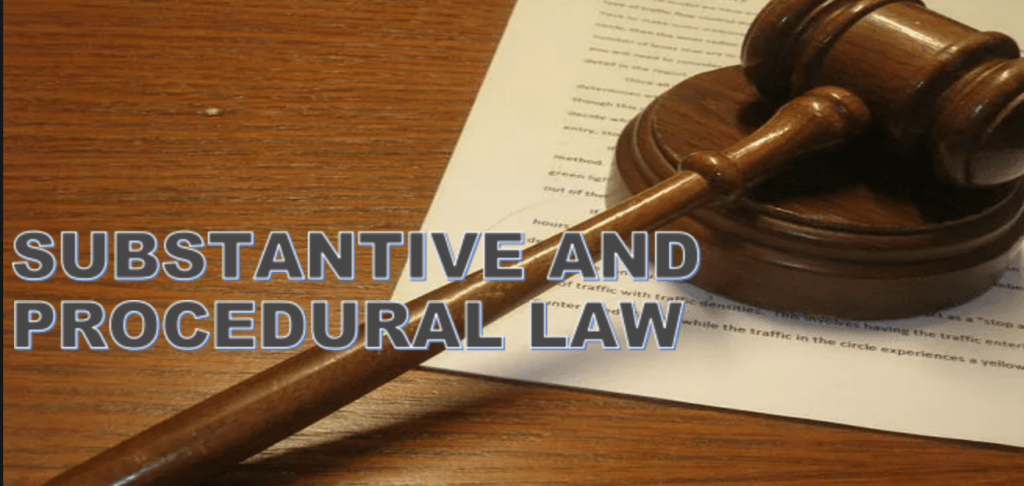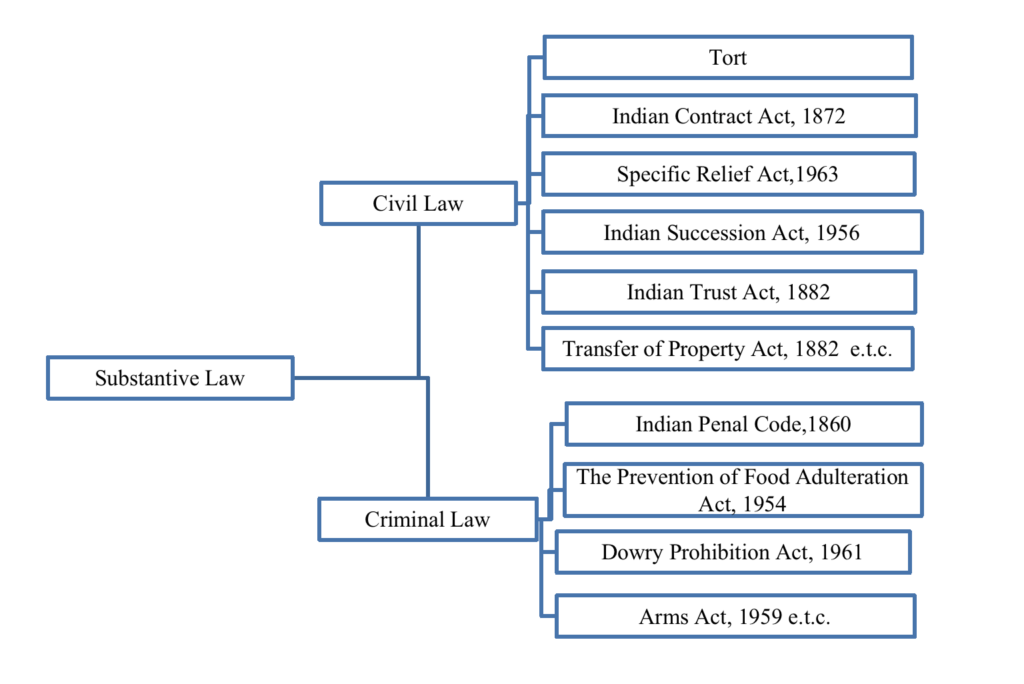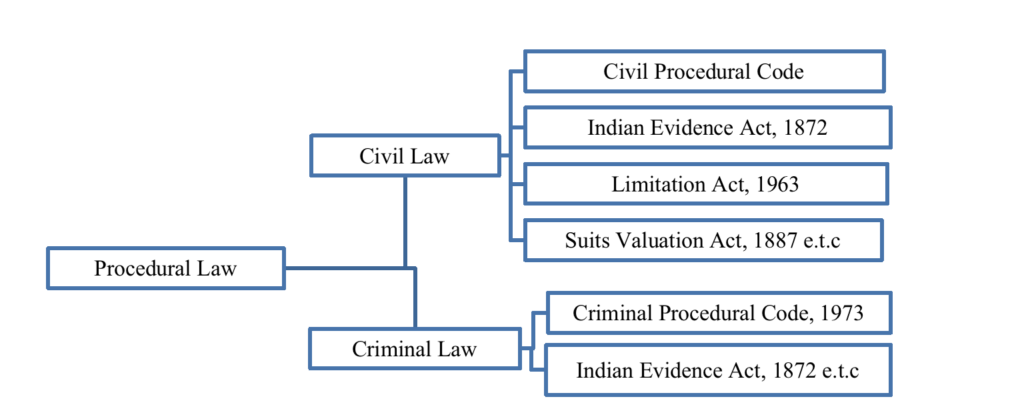
| Amrita Parida of University Law College, Utkal UniversitySemester- 5th Semester, 3rd Year |
ABSTRACT:
The paper is concerned with regards to the meaning and nature of the procedural and substantive law. The types of procedural and substantive law as well has been briefly discussed along with the points of distinction between both the kinds of law.
Keywords: Law, Substantive Law, Procedural law, Juristic View, Personal Law, Criminal Law, Legal System
INTRODUCTION:
Law is regarded to be the hallmark of the modern sovereign nation-states which serves as an instrument to express and enforce the supreme power. Though law is regarded to be a fundamental mechanism for the regulation and control of the behavior of man within any society, in a much broader sense, it is rather a science which concern with not just regulation of the affairs of man but as well of the state and relationship between the states. In brief, law may be regarded as a body of principles which are not only recognised but as well are put into application by states around the world. Law as a discipline is marked by sources, namely, customs, religion, legislation, adjudication, equity and scientific explanation that serve as a means of creation and explanation of the content of law. Furthermore, law is manifested in both abstract form called ‘a law’ and in concrete form called ‘the law’. When law is manifested in its abstract form it is regarded as Jus and when it is manifested in its concrete form it is regarded as lex. Irrespective of any form of manifestation, law is considerably viewed to be classified into two important categories of broad connotations, which are
- Substantive Law
- Procedural Law
A general understanding of both the aforementioned categories of law that forms the central premise of the nature of various legislations of the Indian legal system is significant in view of the prolific application and interpretation of various legislations of India.
A GENERAL JURISTIC APPROACH PERTAINING TO SUBSTANTIVE AND PROCEDURAL LAW:
Bentham is believed to have coined the notions of “substantive” and “adjective” in the year of 1843. However, both the terms “Substantive” and “Adjective” became well-known by virtue of Holland’s “Treatise on Jurisprudence,” which is now widely recognized among scholars.
Despite both kinds of law being crucial in determining the nature and functions of numerous modern day legislation and enactment, and neither kind of law being well effective in the non-existence of the other, there appears to be no consensual opinion with regards to either kind of law as various jurists strongly hold on to various contradictory views.
According to Bentham, the “Substance Law” and the “Procedural Law” can be differentiated distinctly and starkly from one another while retaining the view that it is important that both the kind of law should co-exist. However, Austin hold on to a much more critical opinion with regards to the distinction concerning between the substantive and procedural law as he contemplated a more distinct consideration of purpose of law and undertook the view of portrayal of law exclusively in terms of power with scope for any visible distinction.
Thomas Holland, the British literary lawyer and jurist, outlined substantive law as the laws that articulate how the laws would assist in safeguarding the people’s rights in his famous work of ‘Treatise on Jurisprudence’. Further, he explained procedural law, which is also regarded as adjective law, to be the laws that offer means of promoting and safeguarding rights.
Besides, Salmond was of opinion that the separation concerning substantive and procedural law is primary is of theoretical nature but in operational values the procedural laws either entirely or considerably correspond to the rules pertaining to the substantive laws.
Further, Salmond as well asserts the fact that if one adopts the stance that the process of justice administration in its ordinary form also includes the application of remedies against infringement of rights, then this may suggest that the rules of the substantive law is the one that determine the rights, while the procedural law determine the suitable remedies. However, this distinction between right (jus) and remedy (remedium) is unreliable because, in a wider sense, plenty of rights come even within the umbrella of procedure.
Another legal perspective maintains that “Substance” and “Procedure” are incapable of being differentiated from one another. In the opinion of Charles Frederic Chamberlayne, the boundary of distinction across substantive and procedural law is illusory and fictitious. From a legal point of view, the remedy and the envisioned mechanism are an integral part of the right itself, insofar as the claimant has a legitimate right to employ them.
Professor Cook arrived at a conclusion whereby he reached at the trichotomy-based view and put forth the opinion that besides the notions of substance and procedure, a third area also exists. This third area is grey in nature. Moreover, it is the aimed purpose that considerably determines whether the nature of the law is substantive or procedural.
Thus, it may be concluded that it is inconceivable to even think of developing procedural laws in the absence of any already enacted substantive laws. Similarly, judicial procedural laws are necessary for the equitable and effective utilization of substantive laws. Both the laws are equally vital, and one cannot be adequately applicable being devoid of the other.
SUBSTANTIVE LAW: MEANING AND NATURE
Substantive law is regarded as aiming towards the establishment of a well-defined set of rules and regulations pertaining generally and specifically to the governance of the rights, liabilities, and obligations deemed necessary to be observed by the body of individuals upon whom its applicability extends to. Besides, it is widely considered that the legal relationships among the individual people or between the people and the governing entity is the subject matter of substantive law. However, beyond the legal premise, it holds no applicability. It is the body of law that governs all legal actions, whether they are civil or criminal. Further, in the case of M.V. Elisabeth and ors v. Harwan Investment & Trading Pvt. Ltd. it has been concluded that it is the role of the Court to formulate a procedure by the way of drawing comparisons to other prevalent legal systems when the statute does not provide the required remedy which the substantive law mandates for securing justice for the aggrieved. The nature of substantive law is as follows:
- The central premise with which substantive law deals with is the legal relationships among the individual people or between the people and the governing entity.
- The Substantive law refers to the statutory legislations that establish and articulate precisely that the rights of the general people are to be safeguarded by the law and the obligations of the people should be maintained. It also delineates the offenses and the appropriate remedies against such offence.
- The nature of litigation involving the dispensation of justice is also settled by substantive law.
- The substantive laws have authority to decide any matter independently.
- The statutory framework associated with each crime, including how the case will be conducted and what exact punishment will be provided for the committed offence is determined by substantive laws.
- It is inapplicable in nature beyond the legal premise.
TYPES OF SUBSTANTIVE LAW
The substantive law pertains to all classes of private as well as public law including the civil and criminal law of substantive nature. The substantive law is broadly divided under two important heads which is illustrated diagrammatically below-

Civil law of substantive Nature:
This refers to law that concerns with conflicts arising from dispute between any individual, or any organized entity, or at times with both. In such situation the victim has the right to get compensated. This also encompasses within its purview any private wrong that is a ‘Tort’ that unjustly results in another person suffering loss or hurt giving rise to the liability of the individual committing such a wrongful act. The Law of Contract, which outlines the fundamental elements that are necessary for the creation of contracts, is also a part of substantive civil law. Indian Contract Act, 1872; Hindu Marriage Act; Indian Succession Act, 1956; Specific Relief Act,1963; Transfer of Property Act, 1882; Indian Trust Act, 1882 e.t.c are few examples substantive civil law.
Criminal Law Of Substantive Nature:
The Criminal acts and the concerned punishment with regards to it that is required to be given are covered within the ambit of the substantive criminal laws. Once a defendant breaks a criminal law, a criminal case is launched. The fundamental goal of substantive criminal law is to punish the guilty party, albeit depending on the circumstances, compensation may also be given to the victim. The court employs the substantive laws of criminal nature for the evaluation and determination of the guilt of the accused. Incase, the accused is pronounced to be guilty then the nature and term of punishment is further determined.
PROCEDURAL LAW: MEANING AND NATURE
Procedural Law holds significance with regards to administration of justice in the society as the very nature of procedural law the direct and control the practice, technique, and mechanism employed for the application of the law. Procedural law is described widely to be also called as ‘Adjective Law’ as it provides for the description of implementation of the goals delineated by the substantive rules and regulation. Infact, Madhya Pradesh High Court held the decision in Farookh Mohammed v. the State of Madhya Pradesh (2015) the procedural law should always follow substantive law. Further, in case of Bhagwan Swaroop And Ors. vs Mool Chand And Ors, it is observed that the purpose of the law of procedure is to advance justice, not to obstruct it. Procedural law stems mainly from the supreme law of the land that is the constitutional law, enacted statutes, written rules issued by law enforcement organizations pertaining to their respective employed members, which might not bear the legal enforcement as any other enacted laws but the infringement might culminate in internal punishments; and the Supreme Court’s rules and procedural directives. Holland asserts that although adjectival law largely focuses on the entitlements and conduct of the litigants but it also has deals with variety of other issues like the structure of courts and responsibilities of the judges which comes within the purview of public law. Hence, we may conclude the basic nature of Procedural law to be as follow:
- It establishes the rules and guidelines by the help which the law is applied.
- It pertains to the legal procedure and decides what facts are sufficient to establish a Tort.
- The Procedural law aims at describing the ways and circumstances in which remedies that available against the violated rights can be put to application for the goal securing justice.
- The procedural rules being of adjective in character in its foundation specifically delineate the manner in which the State may bring forth a lawsuit before a court of law.
- It governs which governs all kinds of proceedings of legal nature, whether they are civil or criminal.
- Procedural law as devise a method for the judicious of gathering of evidence; carrying out of any necessary searches; making of required arrests; setting of valid bail; and putting forth the gathered evidence at before the court at the time of trial and procedures concerning sentencing.
TYPES OF PROCEDURAL LAW
The Procedural law is broadly divided under two important heads which is illustrated diagrammatically below-

Civil Law of Procedural Nature:
This refers to the set of laws governing the civil procedure and consists within its ambit the rules, guidelines and standardized procedures that courts must adhere to when hearing cases involving civil issues or while conducting civil trials. It concerns with various civil matters. The rules pertaining to civil cases starting from the institution of plaint to pronouncement of final judgement are well delineated in the civil law of procedural nature. The 1908 enacted law of CPC amalgamates and integrates the various laws that relates to the procedure of the courts having civil jurisdication.
Civil Law of Criminal Nature:
The procedures that are undertaken to penalize someone who defies a criminal law are specified and regulated by law pertaining to criminal procedure. Procedural concerning criminal law is composed of two essential phases, namely, the phases of investigation and adjudication. Police personnel interviewing witnesses and gathering information about the case are the main components of an investigation, along with the arrest of anyone who may have committed a crime. However, the when the suspect person goes through the process of trial in a court of justice for the contended criminal act committed by him, the phase of adjudication is initiated. In Indian context, the 1973 enacted act that is Cr.P.C is said to detail out the procedure concerning criminal offences investigated, tried and sentenced.
POINTS OF DISTINCTION BETWEEN SUBSTANTIVE AND PROCEDURAL LAW:
Despite the possibility of an overlap between these two essential branches of law, both are marked by recognized points of distinction. These are as follows in a tabular form:

CONCLUSION:
To secure the ends of justice, the right must be upheld and the wrong must be made right. The two branches of law, namely, substantive and procedural law endeavour towards to accomplish the above-mentioned proposition.The Substantive law essentially deals with explicitly describing the rights as well as the liabilities concerning not just the individuals but as well as legal entities on whom the law is applicable to. The procedural law, however, concerns itself with the procedures to be followed for the realization of the goals provided by the substantive law. Irrespective of the functions that both the kind of law aims to serve, it is imperative to note that both are not exclusively dependent of each other and rather together forms the conscience of justice system.
REFERENCES:
https://nios.ac.in/media/documents/SrSec338New/338_Introduction_To_Law_Eng/338_Introduction_To_Law_Eng_L11.pdf , last visited on 24/08/2023
https://www.diffen.com/difference/Procedural_Law_vs_Substantive_Law, last visited on 24/08/2023
https://www.thoughtco.com/procedural-substantive-law-4155728 , last visited on 25/08/2023
https://blog.ipleaders.in/substantive-laws-and-procedural-laws/#Juristic_views_on_procedural_laws_and_substantive_laws , last visited on 26/08/2023




0 Comments